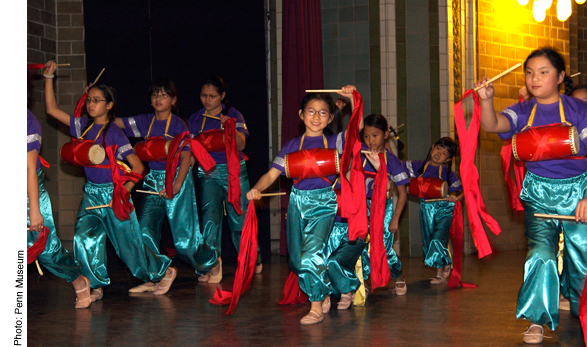Penn Museum's 30th Annual Chinese New Year Celebration: February 12 |
|
February 8, 2011,
Volume 57, No. 21
|
 |
Penn Museum's 30th annual Chinese New Year Celebration, on Saturday, February 12 from 11 a.m. to 4 p.m., will feature the 6-14 year old girls of the MeiMei Dance Troupe, among other performances, at 1 p.m. |
Hop to it and welcome in the Year of the Rabbit! The University of Pennsylvania Museum of Archaeology and Anthropology presents the 30th annual Chinese New Year Celebration Saturday, February 12, from 11 a.m. to 4 p.m.! This PECO World Culture Day features music and dance performances, healing and martial arts demonstrations, games, workshops, children’s activities, and grand opening as well as grand finale lion dance performances. The celebration is free with Museum admission donation ($10 general admission; $7 senior citizens [65+]; $6 students [with ID] and children [6 to 17]; free for children under 6, members, and PennCard holders).
Special presentations bring the sights, sounds and wonders of China to the Museum. Penn Lions, a University of Pennsylvania student group, kick off the celebration with an electrifying lion dance opener.
Chinese for Families students perform traditional dances from the Xinjiang Autonomous Region of China. Chinese for Families is a multicultural Chinese language school offering Mandarin language and dance classes. Students from the school will also present a Chinese language demonstration, teach a Chinese folk song, show a Chinese New Year movie and host a craft workshop where children can try their hands at making Xinjiang dancer puppets.
Qin Qian and Kurt Jung perform traditional and modern Chinese music on the erhu (Chinese two-string fiddle) and the yangchin (Chinese hammered dulcimer). Qin Qian is a well-known erhu performer from Nanning, China, and Kurt Jung is a local Chinese and Western music performer. Both teach Chinese music in the Philadelphia area and have published music books. The duo will demonstrate and discuss the differences and similarities between Chinese and Western music at 11 a.m. and 2 p.m.
Dr. Jingduan Yang, director, Acupuncture & Oriental Medicine Program, Thomas Jefferson University, and founder and medical director, Tao Institute of Mind & Body Medicine, lectures on “A Brief Introduction to Chinese Medicine” at 11 a.m. Dr. Yang discusses the history of Chinese medicine and its similarities, differences, and complementary practices to modern medicine. Between 11 a.m. and 3:30 p.m, visitors can head to the Chinese Rotunda, where staff from the Tao Institute of Mind & Body Medicine talk about different ways of healing in the context of Chinese medicine.
Onlei Annie Jung, a Calligraphy and Chinese painting instructor at the Perkins Center for the Arts, teaches visitors basic brush strokes for writing Chinese Characters and painting at a workshop held from 11 a.m. to 12:30 p.m. Then Onlei returns at 2 p.m. to present a workshop about the ancient Chinese tangram puzzle. Tangrams are a set of seven geometric puzzle pieces used to create distinct shapes from a specific form. Over the centuries, tangrams have amused many from China, Europe, and the Americas, as countless shapes can be made, and the level of difficulty is wide ranging.
A rich line-up of dance performances takes place throughout the day! At 12:30 p.m., Minghui School Dance Team executes classical Chinese dances such as a Tribute to the Holy Lotus and the Sound of Hope. The 6 to 14-year-old girls of the MeiMei Dance Troupe will entertain audiences with a variety of Pan-Asian dances reflecting ancient Chinese tales at 1 p.m. Next, at 2 p.m., the Philadelphia Mulan Dance Troupe performs an engaging routine reflecting China’s long and prominent dance culture, including folk and modern Chinese, Tibetan, and Mongolian dances.
Visitors have the opportunity to practice mind-body self-improvement techniques throughout the day. At 1 p.m., those curious about the health benefits of Tai Chi can participate with Master John Chen, Ba’z Tai Chi & Kung Fu Studio, in a Tai Chi demonstration. Then, at 2 p.m., attendees can join Falun Gong practitioners for mindful exercise and related holistic teachings.
Members of Cheung’s Hung Gar Kung Fu Academy offer an exhilarating Kung Fu demonstration at 3 p.m. in the Harrison Auditorium. Then, at 3:45 p.m., lion dancers and drummers from Cheung’s Academy wind their way from Harrison Auditorium to the Warden Garden, closing the Museum’s New Year celebration with a traditional lion dance to chase away evil and usher in a year of good luck.
Activities for children and families abound in the Museum’s Chinese Rotunda at the Chinese Art Marketplace, from 11 a.m. to 3:30 p.m. Visitors can experience demonstrations by area artists, including paper cutting and Chinese calligraphy, learn more about Chinese New Year traditions, including Chinese zodiac and its legend and how the New Year is celebrated in China, and see the Museum’s much touted 19th century crystal ball —believed to have been owned by the last Dowager Empress, a Chinese ruler in the late 1800s.
Related: Secrets of the Silk Road Modified
|